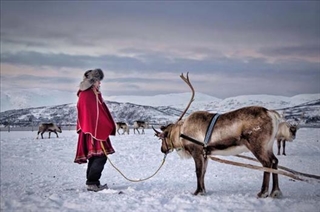 An Evenk & Reindeer
An Evenk & ReindeerWere you ever curious about the Christmas holiday and why we do the things we do? Or where did the origin of the Christmas tree come from. Who is Santa Claus? And how did he get flying reindeer? Defying both time and space to deliver the worlds holiday gifts. Where do these stories come from, and better yet, what are we actually celebrating. There are answers to these questions. And the history is not so unbelievable. You just have to know where to look. And the first place we look is the North Pole. In ancient Siberia, near the top of the world. The story of Santa and his likely origins begins here, where he supposedly lives.
In northern Siberia you will find groups of indigenous people known as the Evenki.
(1) The Evenki were mostly a hunting and gathering society as well as reindeer herders.
(2)(3) Their survival depended upon the reindeer because it provided the Evenki and other northern tribes with everything from clothing, housing material, tools and milk, as well as cultural and religious inspiration. All from just the bones and antlers. The Evenki would also use them for transportation.
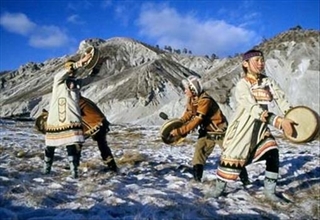 Group of Even (Lamut)
Group of Even (Lamut)The Evenki were also known for shamanism.
(4) The word shaman means "one who knows or knows the spirits.". The shamanic characteristics would later be reflected in cultures all over the world. the shamanic journey or soul flight, is basically the altered states of consciousness. A significant aspect of the shaman is that when they practiced entering these different "states" they were using magic mushrooms. Specifically the Fly Agaric mushroom
(5), or Amanita Muscaria, also more commonly known as the "Alice in Wonderland" mushroom. These mushrooms are native to the Siberia and only grow beneath certain types of evergreen trees.
(6) They form a symbiotic relationship with the roots of the tree, which allows them to grow. These were very sacred to these ancient people, and was used by the shaman and others for ceremonial and spiritual purposes. A reported ancient belief was that the mushroom is actually the fruit of the tree due to the lack of seed, it is also commonly held that these mushrooms Fly Agaric were viewd as divine a kind of virginally birthed sacred plant.
Aside from being intensely psychoactive, the mushrooms are also quite toxic.
(7) A way to reduce the toxicity and increase the psychoactive potency was to simply dry them.
(8) When out collecting the mushrooms, people would pick a bunch of them under the evergreen trees and lay them out along the branches while continuing to pick the mushrooms beneath other trees. The result was something that would of resembled a Christmas tree. So the evergreen trees whose branches are dotted with bright red, roundish "decorations" – in this case the sacred mushrooms.
(9)
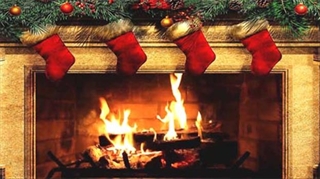 Traditional Christmas stockings hung over a fireplace
Traditional Christmas stockings hung over a fireplaceAt the end of the session, the shaman or harvester would go around to each of their mushroom stashes and put them all in one large sack… a large sack? Does this ring any bells? And not only this, as the story of the tradition goes, the shaman would also visit the homes of his or her neighbors and deliver the mushrooms to them. They would then continue the drying process by hanging them in a sock, near the fire. Another way to reduce the toxicity of the Fly Agaric mushroom is through filtration. After being ingested, and passed through the body, the toxic elements are apparently filtered by the liver and the urine that comes out contains the psychoactive elements.
(5)(10) So apparently they drank the filtered urine. But that’s only half the story. Somewhere in the mythic origins of this practice is the reindeer. Because the reindeer also love these mushrooms. They dig through the snow to eat them, and they also drink their own urine afterwards. So perhaps, long ago, one of the first shamans witnessed the reindeer’s love affair with this particular mushroom and saw how peculiarly it behaved after.
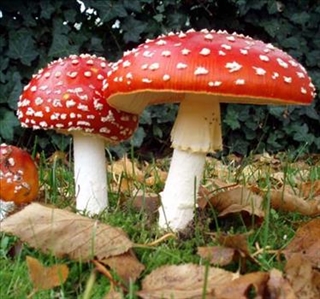 Amanita muscaria, commonly known as the fly agaric or fly amanita mushroom
Amanita muscaria, commonly known as the fly agaric or fly amanita mushroomThe curiosity couldn’t be contained, and the shaman did what they must by first eating some of the yellow snow himself. Realizing the profound wisdom and magic not only in the mushroom, but in the reindeer. It may have happened in antiquity, the connection between the reindeer, and the mushroom. A very common vision that one has while under the influence of Fly Agaric is exactly that, flying.
(3)(11) Distortions of time and space occur, affecting scale in dramatic ways.
(12) Shamanic people are deeply connected in their environment. They learn the magical and mystical properties of the natural world, and often assign a great deal of importance and sacredness to the bearers of that magic. For some of these ancient Siberian people, this power was given by the reindeer and the sacred mushroom.
(4) That the reindeer should have the ability to fly is evident not only in the vision, or their clearly altered state once intoxicated, but also in the wisdom they offered to the Evenki people by eating the mushroom in the first place, and for guiding them to do so just the same.
It wasn’t only the reindeer who could fly, but the shamans also took flight. As mentioned, the shamanic journey or soul flight is a keystone in shamanic practice and especially so in ancient Siberian culture.
(5) In order to connect with the spirits, the shaman had to be able to leave this world and enter theirs.
(13) This was accomplished by projecting his or her spirit from the physical and into the spiritual. They needed the power to do this on their own, or have a spirit helper to take them. It is very common for shamans to develop relationships with birds, naturally, as they have the power to fly. But here, in the North Pole, what better animal to use than the magical, flying reindeer.
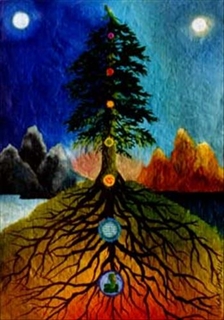 Depiction of the shaman's World Tree
Depiction of the shaman's World TreeThere is another component to the shaman’s flight that corresponds to our story, and this has to do with how they got to the other worlds. The shamanic cosmology often consists of three worlds: the Lower, Middle, and Upper Worlds. Connecting the three worlds is a cosmic axis, which is also commonly known as the World Tree.
(14) The World Tree served as a bridge or portal that allowed a shaman and spirits to move between the three worlds.
(15) It was the gateway as well as the highway. In ancient Siberia, the same tree that also would bare fruit to the mushrooms, also a symbol for the world tree. The Evenki and other tribes lived in roundish, teepee like structures called yurts. Sometimes they would place a pine tree in their yurts for ceremonial purposes.
(16) This symbolized the World Tree, and they would harness its symbolic power to propel their spirit up and out of the yurt through the smoke hole or the chimney. Once the journey was complete, they would return through the smoke-hole/chimney with the gifts from the spirit world. They also believed that the North Star was the very top of the upper world, and because the world tree was an axis that connected the entire cosmology
(17), the north star sat upon the very top of the world tree, which is where the tradition of placing a star at the top of the tree comes from.
One of the elements of the Christmas tradition that we know today is the whole concept of gifting. When you begin to unravel the experience of the shaman’s flight and dance with the Fly Agaric mushroom
(4)(10), you enter a world that is very sacred. These shamanic cultures were interwoven with their environments through the reindeer and the mushroom in a way that honored and celebrated the mysteries and magic that life and experience brought to the people. The shaman’s journey and return was ultra-important to the survival of the whole community.
(2)(5) What they brought back with them was often a matter of life and death. And time and again the shaman and the people, through these experiences that they deemed not only sacred but divine, would learn knowledge and wisdom directly from the sacred plants, their journeys, and from the spirits they interacted with. This was a kind of life blood for their way of being. This was the gift. The celebration was actually a kind of celebration of life, continued survival and renewal. An honoring of the spirits, and natural world that gave them the gift of life.